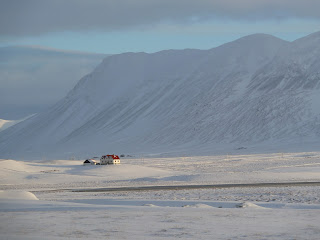Snow in Iceland
The weather in Iceland is terrible. But then it changes.
A perfect example of this was my research trip to Saudárkrókur in northern Iceland in November 2016. It was snowing hard in Reykjavík. I only had four days to get to Saudárkrókur and back, a distance of about three hundred kilometres there and three hundred kilometres back, and I was worried. According to the government website, road travel was not recommended. You don’t argue with Icelanders on the subject of snow: if they say it’s too bad to drive, it’s too bad to drive.
I lost a day, spent in the snow in Reykjavík. The following morning, at about 10 a.m., the website advice changed to a go. So I went.
The first hundred kilometres along the Ring Road were fine. I passed the windy headland by Borgarnes successfully, and drove north through the snow.
Then the road climbed to the notorious Holtavörduheidi, the highlands between the west and the north of Iceland. People lost their way and died trying to cross this on foot or horseback well into the twentieth century, and the weather hasn’t improved since then. Sure enough, I entered cloud and never left it for another hundred kilometres. I drove along at thirty kilometres an hour, both hands on the wheel, staring hard at the road ahead.
There are beautiful lakes and mountains on either side of the road here. So I am told. I didn’t see them. But the snowfall had eased off, the road had been cleared, and I made it to Saudárkrókur.
I didn’t have much time. I visited Glaumbaer in the snow. Glaumbaer is where Gudrid the Wanderer lived after she returned to Iceland from Greenland, and it was where a body was going to be found on page one of my next book, The Wanderer. In August, without snow, when it would look decidedly different. I then visited the local police station, saw two slightly sinister ravens circling in the middle of town, and stayed the night at the Tindastóll, one of the oldest hotels in Iceland. And yes, a discussion with the chambermaid confirmed that there was a ghost in that hotel.
I wanted to give myself plenty of time for the trip back to Keflavík to catch my flight, and so I set off from Saudárkrókur early, while it was still dark. The snow had stopped, the roads were clear, and the sun rose to reveal a sight of pristine beauty. The following hours I drove through some of the most beautiful landscape I have seen in my life.
It wasn’t any one mountain, or any one view. It was a combination of thick newly fallen snow, smooth lakes, dramatic mountain slopes and desolate emptiness, with only the odd, tiny hut showing any sign of habitation.
And the light. During his visit in 1936, W. H. Auden wrote: ‘Iceland is the sun colouring the mountains without being anywhere in sight, even sunk beyond the horizon.’ It’s still true.
There are beautiful lakes and mountains on either side of the road here. So I am told. I didn’t see them. But the snowfall had eased off, the road had been cleared, and I made it to Saudárkrókur.
I didn’t have much time. I visited Glaumbaer in the snow. Glaumbaer is where Gudrid the Wanderer lived after she returned to Iceland from Greenland, and it was where a body was going to be found on page one of my next book, The Wanderer. In August, without snow, when it would look decidedly different. I then visited the local police station, saw two slightly sinister ravens circling in the middle of town, and stayed the night at the Tindastóll, one of the oldest hotels in Iceland. And yes, a discussion with the chambermaid confirmed that there was a ghost in that hotel.
I wanted to give myself plenty of time for the trip back to Keflavík to catch my flight, and so I set off from Saudárkrókur early, while it was still dark. The snow had stopped, the roads were clear, and the sun rose to reveal a sight of pristine beauty. The following hours I drove through some of the most beautiful landscape I have seen in my life.
It wasn’t any one mountain, or any one view. It was a combination of thick newly fallen snow, smooth lakes, dramatic mountain slopes and desolate emptiness, with only the odd, tiny hut showing any sign of habitation.
And the light. During his visit in 1936, W. H. Auden wrote: ‘Iceland is the sun colouring the mountains without being anywhere in sight, even sunk beyond the horizon.’ It’s still true.
The sun in Iceland is always low, but in winter it is particularly low. It appears above the horizon at about ten o’clock, brushing clouds, water and mountainsides pink. Then it rolls along the horizon before sinking in another glorious inferno of orange and red. As I drove, the sunlight reflected off the clouds in a diffuse pink, even at midday, shifting to yellow, grey and purple as it brought the shape of the towering cloud formations into dramatic relief. Patches of clear sky were light blue and pure. The rivers were pink or a burnished copper, depending on the angle the sun struck them; in shadow they were a ruffled black. Ice shifted colour from white to black, via grey, yellow and brown.
That day the scenery was constantly changing, and I was constantly pulling over to take photographs. As I approached the town of Borgarnes, billowing steam was added to the mix, as the vapour from geothermal pools condensed in the cold air.
If you would like to receive a free copy of my 60-page novella The Polar Bear Killing and occasional emails about my books, sign up here.






Comments
Post a Comment